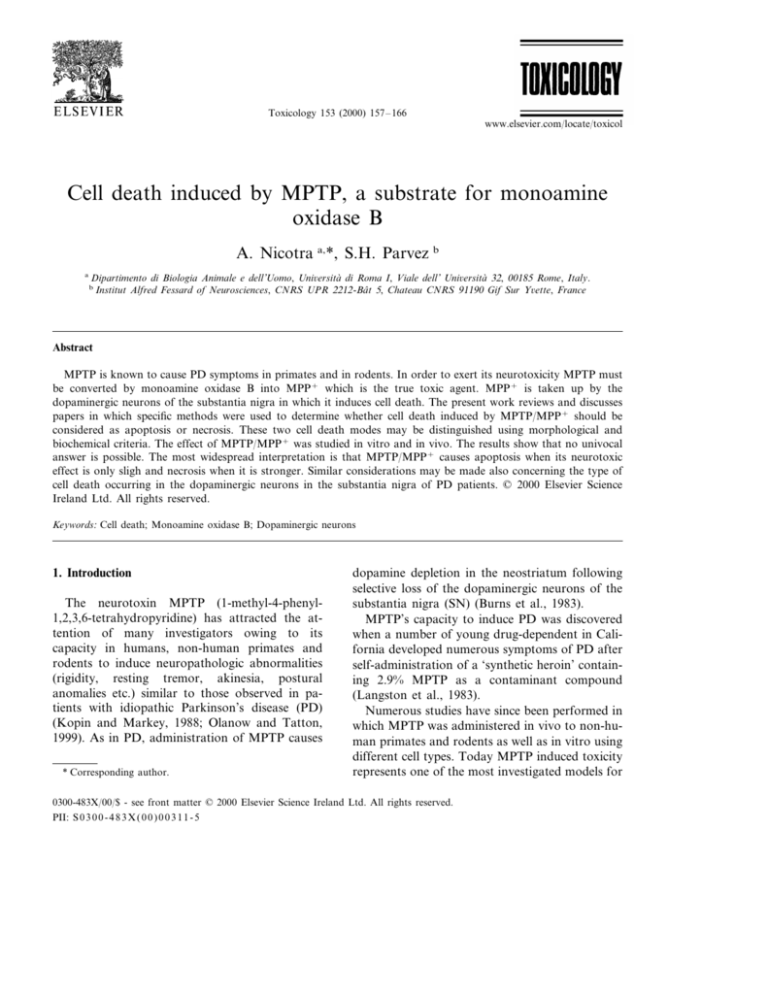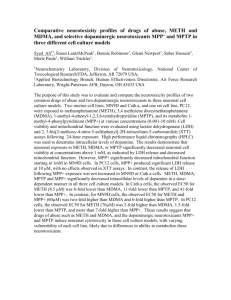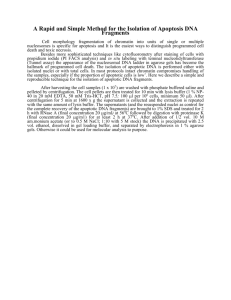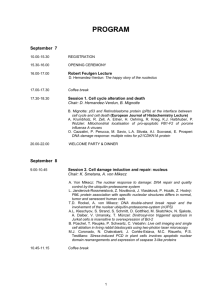
Toxicology 153 (2000) 157 – 166
www.elsevier.com/locate/toxicol
Cell death induced by MPTP, a substrate for monoamine
oxidase B
A. Nicotra a,*, S.H. Parvez b
a
Dipartimento di Biologia Animale e dell’Uomo, Uni6ersità di Roma I, Viale dell’ Uni6ersità 32, 00185 Rome, Italy.
Institut Alfred Fessard of Neurosciences, CNRS UPR 2212 -Bât 5, Chateau CNRS 91190 Gif Sur Y6ette, France
b
Abstract
MPTP is known to cause PD symptoms in primates and in rodents. In order to exert its neurotoxicity MPTP must
be converted by monoamine oxidase B into MPP+ which is the true toxic agent. MPP+ is taken up by the
dopaminergic neurons of the substantia nigra in which it induces cell death. The present work reviews and discusses
papers in which specific methods were used to determine whether cell death induced by MPTP/MPP+ should be
considered as apoptosis or necrosis. These two cell death modes may be distinguished using morphological and
biochemical criteria. The effect of MPTP/MPP+ was studied in vitro and in vivo. The results show that no univocal
answer is possible. The most widespread interpretation is that MPTP/MPP+ causes apoptosis when its neurotoxic
effect is only sligh and necrosis when it is stronger. Similar considerations may be made also concerning the type of
cell death occurring in the dopaminergic neurons in the substantia nigra of PD patients. © 2000 Elsevier Science
Ireland Ltd. All rights reserved.
Keywords: Cell death; Monoamine oxidase B; Dopaminergic neurons
1. Introduction
The neurotoxin MPTP (1-methyl-4-phenyl1,2,3,6-tetrahydropyridine) has attracted the attention of many investigators owing to its
capacity in humans, non-human primates and
rodents to induce neuropathologic abnormalities
(rigidity, resting tremor, akinesia, postural
anomalies etc.) similar to those observed in patients with idiopathic Parkinson’s disease (PD)
(Kopin and Markey, 1988; Olanow and Tatton,
1999). As in PD, administration of MPTP causes
* Corresponding author.
dopamine depletion in the neostriatum following
selective loss of the dopaminergic neurons of the
substantia nigra (SN) (Burns et al., 1983).
MPTP’s capacity to induce PD was discovered
when a number of young drug-dependent in California developed numerous symptoms of PD after
self-administration of a ‘synthetic heroin’ containing 2.9% MPTP as a contaminant compound
(Langston et al., 1983).
Numerous studies have since been performed in
which MPTP was administered in vivo to non-human primates and rodents as well as in vitro using
different cell types. Today MPTP induced toxicity
represents one of the most investigated models for
0300-483X/00/$ - see front matter © 2000 Elsevier Science Ireland Ltd. All rights reserved.
PII: S 0 3 0 0 - 4 8 3 X ( 0 0 ) 0 0 3 1 1 - 5
158
A. Nicotra, S.H. Par6ez / Toxicology 153 (2000) 157–166
studying the pathogenesis of PD (Gerlach and
Riederer, 1996). However, its action mechanism is
still not fully understood (Sayre, 1989; Tipton and
Singer, 1993). MPTP is a lipophilic molecule able
to cross the blood-brain barrier and in order to
induce neurotoxicity oxidative deamination by the
monoamine oxidase B must occur, to convert it
into an unstable intermediate MPDP+ (1-methyl4-phenyl-2,3-dihydropyridinium ion). The latter is
further converted to the pyridinium ion MPP+
(1-methyl-4-phenylpyridinium ion), which is the
true toxic agent. MAO B, which thus plays a
crucial role in the neurotoxic process, is present in
comparatively large quantities in the glial cells in
which the reaction takes place. MPP+ is a polar
molecule and once released from the glial cells is
selectively taken up by terminals and cell bodies
of dopaminergic neurons by the dopamine transporter of the plasmatic membrane (Irwin and
Langston, 1995; Santiago et al., 1996). Inside the
cells MPP+ is accumulated in mitochondria where
it inhibits enzymes of the respiratory chain. This
alters oxidative phosphorylation and leads to
APT-exhaustion. In addition to energy depletion
and disruption of the mitochondrial membrane
potential, generation of free radicals and breakdown of calcium homeostasis occur (Di Monte et
al., 1986; Rossetti et al., 1988; Tipton and Singer,
1993). A similar scenario has been proposed also
for PD (Hirsch, 1999). Several studies suggest that
MPP+ also leads to an increased production of
nitric oxide (Przedborski et al., 1996; Matthews et
al., 1997). Nitric oxide reacts with the superoxide
anion to produce a highly reactive agent such as
peroxynitrite, a possible cause of cell death (Beckman, 1996).
It has been observed however that MPTP/
MPP+ may cause cell death also via mechanisms
that do not involve mitochondrial damage (Khan
et al., 1997) and other alternative mechanisms of
MPTP/MPP + action have been proposed (Tipton and Singer, 1993; Przedborski and JacksonLewis, 1998). The mode of cell death induced by
MPTP is an interesting but still rather controversial aspect. Do the dopaminergic neurons undergo
apoptosis or necrosis or both? This is a crucial
point also in the understanding of PD
pathogenesis.
In early work on the effects of MPTP the
occurrence of cell death in SN was reported, but
no efforts were made to distinguish the mode of
cell death. Cell death was identified for example
by measuring the decrease in the number of TH
(tyrosine hydroxylase) positive neurons in the SN.
TH is a rate-limiting enzyme in catecholamine
synthesis and thus represents a marker for dopaminergic neurons. However, MPTP may cause
a decrease or a disappearance of the enzyme
without producing neuronal death. When cell cultures were used, the LDH (lactate dehydrogenase)
leakage into the medium was measured. In subsequent papers, however, the authors began to
provide more specific evidence in support of one
or other of the cell death modes, on the basis of
both morphological and biochemical criteria and
even, more recently, investigated the presence or
absence of specific molecules known to play critical roles in apoptosis (Susin et al., 1998). Most of
these studies were performed by using cell cultures. In other papers, however, MPTP/MPP+
was administered in vivo to mice. This experimental approach is of fundamental importance. Indeed even if cell cultures are easier to manipulate
and provide a more uniform response to the
treatment, it is by no means certain that cell
cultures will behave like the original tissue. In the
present review we start out by describing the
distinctive features of apoptosis and necrosis and
then the methods commonly used in research on
the effect of MPTP, in order to distinguish between the two types of cell death. In the following
sections we will summarize and discuss papers in
which experiments were performed to determine
whether the cell death caused by MPTP/MPP + ,
in vitro and in vivo systems, shows apoptotic or
necrotic characteristics.
2. Characteristics of apoptosis and necrosis.
Investigation methods
Apoptosis is involved in many physiological
and pathological processes and is characterized by
constant degenerative changes (Kerr et al., 1972,
1995). During classic apoptosis cells undergo dramatic shrinkage accompanied by membrane bleb-
A. Nicotra, S.H. Par6ez / Toxicology 153 (2000) 157–166
bing. Cell surface specializations like microvilli
are lost and cells are detached from their neighbors. Lastly, they break up into several membrane-bound apoptotic bodies. Apoptotic cells
and apoptotic bodies initially retain an intact
membrane which is impermeable to vital dyes.
Also the organelles present are well conserved.
Mitochondria remain intact even though mitochondrial dysfunction is associated with apoptosis
(Susin et al., 1998). On the other hand, there are
very evident and usually early signs of changes in
the nucleus. Chromatin condenses and forms crescent-shaped aggregates which line the nuclear envelope before breaking up into multiple bodies at
a later stage. They may or may not be present in
the apoptotic bodies. Apoptotic bodies are rapidly
phagocytosed by macrophages or by neighboring
cells that have become phagocytic. This rapid
clearance of the apoptotic bodies prevents any
inflammatory response. The entire process is very
rapid and in many cellular types takes about 1 – 3
h and usually occurs in scattered individual cells
in a tissue.
Apoptosis is induced by different kinds of stimulus that trigger a mechanism leading to the activation of cysteine proteases known as caspases
which target well defined nuclear and cytoplasmic
substrates (Cryns and Yuan, 1998). It is also
known as programmed cell death as it represents
a physiological process requiring de novo gene
expression and that may be delayed or prevented
by treatment with inhibitors of RNA and protein
synthesis. A number of authors consider it more
correct to state that several different forms of
programmed cell death exist, one of the most
common of which is apoptosis (Bowen, 1993).
The issue is further complicated by the fact that
not always does the presence of morphological
features of apoptosis correspond to programmed
cell death (McConkey et al., 1988; Aw et al., 1990;
Perrotti et al., 1990; Bellomo et al., 1992).
Necrosis is quite different from programmed
cell death (Kerr et al., 1995). This process is the
result of cellular injury or marked changes in cell
homeostasis, takes place simultaneously in groups
of adjacent cells and is not genetically controlled.
The chromatin condenses into aggregates, which
tend to have irregular or ill-defined boundaries
159
and the nucleus never splits up into fragments.
The cytoplasm swells and, in advanced necrosis,
the plasmatic membrane and that of the organelles gradually disintegrate. The final stage is
cell lysis followed by an acute inflammatory
response.
Apoptosis and necrosis may thus in the first
instance be distinguished on the basis of morphological characteristics. The latter may be observed
under the light microscope, for instance, after
staining with hematoxylin and eosin, which allows
chromatin condensation to be recognized as pyknosis. Both in tissue sections and in cultured
cells chromatin changes occurring during apoptosis can easily be recognized after staining with
fluorescent DNA binding dyes like Hoechst 33258
or Acridine Orange. Electron microscope is an
effective tool for a detailed observation of morphological apoptotic changes. In the case of cell
cultures it is also possible to reconstruct a temporal sequence of changes. However, in in vivo
studies electron microscopy, as well as being a
fairly laborious process, does not allow the procedure to be quantified.
As far as its quantification is concerned, it must
be taken into account that apoptosis is a dynamic
process and that distinctive morphological
changes can be recognized only in one portion of
apoptotic cells at any one point in time. The
number of cells undergoing apoptosis in a tissue is
liable to be underestimated. One important aspect
to bear in mind is that when studying cell cultures, those undergoing apoptosis are not scavenged rapidly as happens in vivo, and after a
certain period of time they undergo changes similar to those observed in necrosis. These changes
include swollen mitochondria, electron lucent cytoplasm, loss of membrane integrity and ultimately cell lysis. This phenomenon is defined as
secondary necrosis (Sloviter et al., 1993).
It is not always easy to distinguish between
apoptosis and necrosis simply by means of morphological assessments. The morphological criteria must therefore be backed up by biochemical
criteria and vice versa. One of the most frequently
used biochemical criteria is the detection of the
double-strand cleavage of nuclear DNA in the
nucleosomal linker regions that underlines the
160
A. Nicotra, S.H. Par6ez / Toxicology 153 (2000) 157–166
structural changes in the nuclear chromatin during apoptosis (Wyllie, 1980). This non-random
cleavage of DNA is mediated by endonucleases
and produces fragments of 180 – 200 bp and integer multiples thereof. The occurrence of oligosomal DNA fragmentation can be verified by the
presence of a ‘ladder’ of bands after electrophoresis on an agarose gel (Wyllie et al., 1984). DNA
laddering is considered a biochemical hallmark of
apoptosis. However, several cell types, although
displaying morphological features typical of apoptosis, have been found to lack internucleosomal
DNA cleavage. Other types of DNA degradation
are instead characterized by single strand cleavage. Furthermore, the method is non-quantitative
and cannot always be applied to in vivo situations
in which there is only a small number of cells
undergoing simultaneous cell death. Moreover it
cannot tell us what cells in a tissue are undergoing
apoptosis. For this purpose methods have been
developed that allow us to recognize 3%-ends generated by endonuclease cleavage of genomic DNA
during apoptosis in situ, by conventional light
microscopy, in cultured cells or in tissue sections
processed by a histological method. These methods are known as ISEL (in situ end-labeling) and
are based on the fact that the DNA internucleosomal cleavage generates free 3%-ends (Gavrieli et al.,
1992; Mesner and Kaufmann, 1997). They attach
a chromogen or fluorochrome to the free 3%-end of
nuclear DNA. The most common is TUNEL.
TUNEL stands for TdT-mediated dUTP nick
end-labeling or in situ end labeling. TdT (terminal
deoxynucleotidyl transferase) is a primer dependent DNA polymerase that catalyzes the addition
of nucleosides to exposed 3%-ends of DNA. In this
method TdT is used to incorporate biotinylated
deoxyuridine triphosphate (dUTP) into the sites
of DNA breaks. The signal is amplified in various
ways. For instance, it is possible to use avidin
peroxidase, followed by light microscopy. Or else
digoxigenin-11-dUTP may be used as label. The
latter is detected using digoxigenin antibody and
chromogenic detection with DAB-peroxidase.
TUNEL is a very sensitive method able to detect
a limited number of DNA strand breaks in apoptotic cells, even in the early phases of cell death. It
also allows quantification of the apoptotic cells
within a given population. One drawback of
TUNEL is that it can also detect random DNA
degradation which is a late-stage phenomenon of
necrosis. Also cells undergoing mitosis are
TUNEL positive ( Gavrieli et al., 1992; Migheli et
al., 1994). When this method is used it must be
borne in mind that fixation by formalin may be
critical and can be a source of error. TUNEL
positivity is in fact not detectable after long fixation periods (Davidson et al., 1995).
As well as by methods based on morphology
and on the detection of DNA fragmentation,
apoptosis may also be revealed using various
other methods, such as flow cytometry, annexin V
staining, enzyme assays, comet assay, etc. For a
description of these methods see Mesner and
Kaufmann (1997) and Maruyama and Naoi
(1998). Other studies endeavour to analyse the
expression of key molecules controlling programmed cell death (Susin et al., 1998). These
include Bcl-2, an anti-apoptotic protein, and Bax,
an apoptosis-promoting protein. Caspase inhibitors are also used to provide evidence of
apoptosis.
3. Apoptosis evidence after in vivo treatment with
MPTP
Experiments using methods to identify apoptosis in SN after in vivo administration of MPTP to
mice, are described by Jackson-Lewis et al. (1995)
and Tatton and Kish (1997). However, the results
obtained by these two research groups are in
disagreement (Table 1).
Jackson-Lewis et al. (1995) gave mice four intraperitoneal injections of 20 mg/kg MPTP at 2 h
intervals. The mice were then sacrificed at different intervals of time. Then SN neurons were
examined using various methods. Nissl staining
and silver staining were used to study neuron
morphology. Degenerating neurons displayed
shrunken eosinophilic cytoplasm and shrunken,
darkly-stained nuclei. Degeneration was already
evident at 12 h post-injection and continued up to
4 days. DNA fragmentation was verified by
TUNEL. No dying neurons TUNEL-positive
were found. In the same work also doses as low as
A. Nicotra, S.H. Par6ez / Toxicology 153 (2000) 157–166
40 – 60 mg/kg total were tested. The lower concentration did not cause any neuron degeneration. At
60 mg/kg the percentage cell death was lower than
at 80 mg/kg. Also in this case the morphology of
the degenerating neurons did not show features of
apoptotic cell death.
Tatton and Kish (1997) used different experimental conditions to determine whether the dopaminergic nigral neurons died via an apoptotic
mechanism after MPTP treatment. Mice were injected with 30 mg/kg MPTP daily for 5 days.
MPTP-injected mice were killed after 2.5 – 5 days
of treatment and after 3.5 and 10 days after the 5
days of treatment. ISEL-positive cells were observed within 72 h of the first injection of MPTP
and these reached the maximum value 24 h after
the last MPTP injection. The observed TUNEL –
positivity corresponded to nuclear chromatin condensation, as shown by means of Acridine Orange
stain on alternate sections.
According to Tatton and Kish (1997) the discrepancy with the work of Jackson-Lewis et al.
(1995) could be accounted for by the different
MPTP concentrations used and by the different
times of administration. The experimental conditions adopted by Jackson-Lewis et al. (1995) may
have led to the accumulation of a high MPP+
level in the mitochondria and consequently to
non-apoptotic cell death.(see Table 1)
In order to investigate the molecular mechanisms involved in neuronal degeneration following MPTP administration Hassouna et al. (1996)
studied the effect of in vivo MPTP treatment on
the expression of the protein Bax, an apoptosis
promoter. Adult mice received four intraperitoneal injections of 20 mg/kg MPTP at 4 h intervals and were killed 3 and 6 days after the first
injection. Only mice displaying rigor and akinesia
after MPTP treatment were examined. In these
161
animals a significant increase in bax mRNA synthesis in the SN (3 fold after 6 days) was found.
Also an increase in Bax immunoreactivity was
observed, mainly in large and medium size neurons in the SN that are doomed to die.
4. Apoptosis evidence after in vitro treatment with
MPTP/MPP+
4.1. Cerebellar granule neurons
Some of the earliest evidence that MPTP causes
apoptosis comes from Dipasquale et al. (1991)
who used cerebellar granule neurons obtained
from 8-day-old rat pups. Treatment was performed using 50 mM MPP+ for 4 days (Table 2).
After 3 days of treatment the cells observed with
Nomarski optic showed morphological changes
typical of apoptosis. The percentage of apoptotic
granule cells after MPP+ treatment for 4 days was
30% higher than in control cultures. When granule cells were incubated with cycloheximide (1
mg/ml) to inhibit protein synthesis, apoptosis was
greatly reduced both in the absence and presence
of MPP+. Agarose gel electrophoresis of the
DNA showed an evident internucleosomal DNA
fragmentation after MPP+ treatment.
Du et al. (1997) used the same system to further
characterize MPP+ effects by varying the MPP+
concentrations and the treatment times.
They concluded that the mode of cell death
induced by MPP+ is both concentration and
time-dependent. The treatment must last at least
72 h and the concentration must be increased to
60–100 mM in order to achieve a significant percentage of cell degeneration. Cells were examined
for the presence of internucleosomal DNA fragmentation after exposure to MPP+ 10–2000 mM.
Table 1
Evidence for apoptosis after in vivo administration of MPTP to mice
MPTP treatment
Methodology
Apoptosis
References
20 mg/kg, 4× at 2 h intervals
30 mg/kg, daily for 5 days
20 mg/kg, 4× at 4 h intervals
TUNEL
TUNEL, Acridine Orange
Bax expression
−
+
+
Jackson-Lewis et al., 1995
Tatton and Kish, 1997
Hassouna et al., 1996
162
A. Nicotra, S.H. Par6ez / Toxicology 153 (2000) 157–166
DNA laddering was evident in cells exposed to 60
mM MPP+. However, DNA laddering was not
observed in cells treated with \ 500 mM MPP+.
Accordingly, nuclear apoptotic changes were detected with Hoechst 33258 in cerebellar granules
treated with 60 mM MPP+. With MPP+ 500 mM
for 12 h, cell death showed necrotic features.
Other data suggest that the observed apoptosis is
mediated by activation of a caspase-3-like
protease. A specific inhibitor of this caspase significantly inhibited the apoptotic but not the necrotic cell death. Cytoplasmic extracts prepared
from MPP+-treated cerebellar granules showed a
higher activity of a caspase-3-like protease. The
activation of a caspase3-like protease thus seems
to be involved in the apoptotic events elicited by
MPP+ in these cell.
4.2. PC12 cells
PC12 cells, a clonal rat pheochromocytoma cell
line, have been frequently used to study the effects
of MPP+. PC12 cells are dopaminergic and possess the dopamine transporter in the plasmatic
membrane (Rebois et al., 1980).
Hartley et al. (1994) observed that treatment
with MPP+ 10 mM – 1 mM for 48 h induced a
dose-dependent cell death in undifferentiated
PC12 cells. Cell death was assessed by LDH
release. Electron microscopic observations of
these cells evidenced typical apoptotic changes
and agarose gel electrophoresis of DNA revealed
typical DNA laddering. It was observed, however,
that although at MPP+ concentrations greater
than 100 mM a high percentage of cell death
occurred, the maximal DNA fragmentation was
found with MPP+ 10 – 25 mM. This would seem to
indicate that apoptosis prevails at low MPP+
concentrations and necrosis at higher MPP+
concentrations.
Different results were recently reported by
Soldner et al. (1999). PC12 cell death was assayed
by light microscopy, trypan blue exclusion, and
LDH release. Unlike Hartley et al. (1994) Soldner
et al. (1999) did not observe any cell death at
MPP+ concentrations lower than 250 mM. Using
higher MPP+ concentrations cells degenerated,
but no evidence was found of the presence of any
apoptotic cells. After treatment with 50 mM and
250 mM MPP+ for 48, 72 and 96 h the cells
showed no DNA fragmentation nor any increase
in TUNEL positivity. The absence of apoptosis
was confirmed by the fact that caspase inhibitors
had no effect on cell death induced by MPP+.
According to Soldner et al. (1999) the dissimilarity in response versus Hartley et al. (1994) could
be accounted for by differences in the cell lines
used.
Mutoh et al. (1994) used PC12 cells differentiated into a sympathetic neuron-like phenotype
after long term (5 days) NGF (nerve growth
factor) treatment. After treatment with MPP+
(100 mM) for 4 h the cells still showed neurites but
some of them appeared to be more irregular and
somewhat shrunken. Exposure to MPP+ for 52 h
caused complete retraction of the neurites. When
DNA was extracted after treatment with MPP+
for 4 h, a typical DNA laddering was found by
agarose gel electrophoresis. The cotreatment with
cycloheximide inhibited DNA fragmentation of
the cells. The authors did not observe DNA laddering in undifferentiated PC12 cells treated with
MPP+ (100 mM) only. The latter finding is in
agreement with the data of Soldner et al. (1999).
4.3. Mesencephalic dopaminergic neurons
A useful model for the action of MPP+ is
provided by mesencephalic dopaminergic neurons
obtained from ventral mesencephalic-striatal coculture (Mochizuki et al., 1994). Cultures were
prepared from the ventral mesencephalon and
neostriatum of rat embryos at embryonic day 14
and treatment was with 20 mM MPP+ for 48 h.
Marked characteristic changes were observed in
chromatin condensation with hematoxylin-staining in TH-positive neurons. DNA fragmentation
was demonstrated on agarose gel and TUNELpositive cells were found. Non-dopaminegic cells
were only slightly affected by MPP+. These data
demonstrate that MPP+ induced neuronal death
is due to an apoptotic process.
A dopaminergic cell line derived from embryonic murine mesencephalon, MN9D (Choi et al.,
1991) was used by Oh et al. (1995). Treatment
with 1–100 mM MPP+ for 2–48 h induced cell
A. Nicotra, S.H. Par6ez / Toxicology 153 (2000) 157–166
death, although without the nuclear morphological changes typical of apoptosis. The nuclei were
examined via Hoechst 33258 staining. Furthermore gel electrophoresis of DNA showed no
DNA laddering. However, the authors claimed
that cell death was not due to necrosis, as the
process was dependent on new protein synthesis.
This was confirmed by other observations made
using MN9D cells stably expressing Bcl-2. Overexpression of Bcl-2 in these cells attenuated cell
death induced by MPP+.
The type of cell death induced by MPP+ in
MN9D cells was further investigated in a recent
paper by Choi et al. (1999) using MPP+ concentration ranges similar to those used to demonstrate apoptotic cell death in PC12 and cerebellar
granular neurons.
Treatment of MN9D cells with MPP+ (100 mM
for 40–44 h for maximum effect) caused doseand time-dependent cell death. Examination of
the fine structural details revealed typical necrotic
manifestations. These morphological changes
were induced as early as 10 – 12 h after 100 mM
MPP+ treatment. It was also observed that some
caspase inhibitors did not reduced MPP+-induced
degenerating cells. According to Oh et al. (1995),
MPTP-induced cell death in MN9D cells thus
resembled necrotic cell death as judged by morphological and biochemical criteria. Interestingly,
other experiments demonstrated that reactive oxygen species (ROS) did not seem to play an essential role in MPP+ induced necrosis in this cell line
(Choi et al., 1999). In fact the levels of ROS
following MPP+ treatment did not significantly
increase and simultaneous treatment of cells with
anti-oxidants did not rescue from MPP+ induced
cell death.
4.4. SH-SY5Y cells
Itano and Nomura (1995) used a human neuroblastoma cell line (neuronal-like SH-SY5Y
cells). LDH leakage assay was used to estimate
the cell death. Cells were treated with 1 mM
MPP+ for several days (1 – 6 days). At day 4 after
treatment 35% of the total LDH activity was
found in the culture medium and nucleosomal
fragments of 180 bp were clearly observed, indi-
163
cating that cell death occurred through apoptosis.
In other experiments the effects of 1 mM MPP+
on the level of Bcl-2 protein were investigated.
The level of Bcl-2 protein increased at 4 and 6
days after treatment. Bcl-2 protein increase, but
no MPP+ induced cell death, was inhibited by
pretreatment with staurosporine a protein kinase
inhibitor, indicating that these enzymes are involved in the stimulation of Bcl-2 synthesis.
Induction of apoptosis by MPP+ in neuroblastoma cells was confirmed by Sheehan et al. (1997).
Cells were treated with 80 mM MPP+ for 24 h.
Bisbenzimide (similar to Hoechst 33258 stain)
coupled with transmission electron microscopy
was used to assess whether MPP+ induced apoptosis in this cell line. Furthermore it was found
that bisbenzimide stained nuclei also stained positively with the TUNEL method. Ultrastructural
analysis revealed the presence of cells showing
morphological characteristics of secondary necrosis after continued exposure to MPP+ (see Table
2).
5. Conclusions
Numerous investigators have attempted to
demonstrate whether the pathway of cell death of
the dopaminergic neurons of the substantia nigra
in PD neurodegeneration is to be classified as
apoptosis or as necrosis(see Table 3). However the
obtained results have provided conflicting results
and only in some cases the mechanisms of MPTP/
MPP+-elicited cell loss appear to be apoptotic.
(Mochizuki et al., 1996; Anglade et al., 1997;
Kösel et al., 1997; Burke, 1998; Jellinger, 1998).
The study of these problems in PD patients encounters specific difficulties due, among other
things, to the use of post-mortem tissues as well as
to the fact that the neurodegenerative events accompanying the development of PD appear
slowly and progressively. In order to overcome
these problems MPTP/MPP+ induced neurotoxicity has been used extensively. Nevertheless, from
the analysis of the cell death mode caused by the
in vitro and in vivo administration of MPTP/
MPP+ it appears that it is not always possible to
distinguish inequivocally between apoptosis and
164
A. Nicotra, S.H. Par6ez / Toxicology 153 (2000) 157–166
Table 2
Evidence for apoptosis after in vitro MPP+ treatment of different cell types
Cell type
MPP+ Treatment
Methodology
Cerebellar granule neurons from
rat pups
Cerebellar granule neurons from
rat pups
PC12 cells, undifferentiated
50 mM for 4 days
DNA gel electrophoresis,cycloheximide +
60 mM for at
least 72 h
10–25 mM for 48
h
50-250 mM for
48–96 h
100 mM for 4 h
DNA gel electrophoresis, Hoechst
33258
DNA gel electrophoresis, Electron
microscopy
TUNEL, caspase inhibitors
PC12 cells, undifferentiated
PC12 cells, differentiated
Dopaminergic neurons from rat
embryos
MN9D
20 mM for 48 h
Apoptosis
DNA gel electrophoresis,
cycloheximide
DNA gel electrophoresis,TUNEL
+
+
−
+
+
DNA gel electrophoresis,Hoechst
−
33258
Electron microscopy, caspase inhibitors −
SH-SY5Y cells
1–100 mM for
2–48 h
100 mM for 10–44
h
1 mM 4 days
DNA gel electrophoresis
+
SH-SY5Y cells
80 mM for 24 h
Electron microscopy,
TUNEL,bisbenzimide
+
MN9D
References
Dipasquale et al.,
1991
Du et al., 1997
Hartley et al.,
1994
Soldner et al.,
1999
Mutoh et al.,
1994
Mochizuki et al.,
1994
Oh et al., 1995
Choi et al., 1999
Itano and
Nomura, 1995
Sheehan et al.,
1997
Table 3
Evidence for apoptosis in neurons from substantia nigra of patients with PD
Number of patients
Methodology
Apoptosis
References
3
11
22
Electron microscopy
TUNEL
TUNEL
+
+
−
Anglade et al., 1997
Mochizuki et al., 1996
Kösel et al., 1997
necrosis and the question remains to be resolved.
The apparent inconsistencies in the mode of
MPTP/MPP+ induced neuronal loss may be explained in some cases assuming that MPTP/
MPP+ can probably cause both apoptotic and
necrotic death depending on the severity of the
injury. If this is low, cell death is apoptotic. At
high levels passive necrotic death probably predominates. A similar interpretation could also be
relevant to the understanding of the pathogenesis
of idiopathic PD (Burke, 1998). In the years to
come new insights into how neurons degenerate
after MPTP/MPP+ treatment may perhaps be
provided by using transgenic animals with altered
expression of genes involved in the pathway of
apoptotic cell death.
References
Anglade, P., Vyas, S., Javoy-Agid, F., Herrero, M.T., Michel,
P.P., Marquez, J., Mouatt-Prigent, A., Ruberg, M.,
Hirsch, E.C., Agid, Y., 1997. Apoptosis and autophagy in
nigral neurons of patients with Parkinson’s disease. Histol.
Histopathol. 12, 25 – 31.
Aw, T.Y., Nicotera, P., Manzo, L., Orrenius, S., 1990. Tributyltin stimulates apoptosis in rat thymocytes. Arch.
Biochem. Biophys. 283, 46 – 50.
Beckman, J.S., 1996. Oxidative damage and tyrosine nitration
from peroxynitrite. Chem. Res. Toxicol. 9, 836 – 844.
Bellomo, G., Perotti, M., Mirabelli, F., Finardi, G., Nicotera,
P., Orrenius, S., 1992. Tumor necrosis a factor induces
apoptosis in mammary adenocarcinoma cells by an increase in intranuclar free Ca2 + concentration and DNA
fragmentation. Cancer Res. 52, 1342 – 1346.
Bowen, I.D., 1993. Apoptosis or programmed cell death? Cell
Biol. Int. 17, 365 – 380.
A. Nicotra, S.H. Par6ez / Toxicology 153 (2000) 157–166
Burke, R.E., 1998. Programmed cell death and Parkinson’s
disease. Mov. Disord. 13, 17–23.
Burns,R.S.,
Chiueh,C.C.,
Markey,
S.P.,
Ebert,
M.H.,Jacobowitz, D.M and Kopin, I.J., 1983. A primate
model of parkinsonism: selective destruction of dopaminergic neurons in the pars compacta of the substantia nigra by
N-methyl-4-phenyl-1,2,3,6-tetrahydropyridine
Choi, H.K., Won, L.A., Kontur, P.J., Hammond, D.N., Fox,
A.P., Wainer, B.H., Hoffmann, P.C., Heller, A., 1991.
Immortalization of embryonic mesencephalic dopaminergic
neurons by somatic cell fusion. Brain Res. 552, 67–76.
Choi, W.S., Yoon, S.Y., Oh, T.H., Choi, E.J., O’Malley, K.L..,
Oh, Y.J., 1999. Two distinct mechanisms are involved in
6-hydroxydopamine- and MPP+-induced dopaminergic
neuronal cell death: role of caspases, ROS, and JNK. J.
Neurosci. Res. 57, 86–94.
Cryns, V., Yuan, J., 1998. Proteases to die for. Genes Dev. 12,
1551 – 1570.
Davidson, F.D., Groves, M., Scaravilli, F., 1995. The effect of
formalin fixation on the detection of apoptosis in human
brain by in situ end-labeling of DNA. Histochem. J. 27,
983 – 988.
Di Monte, D., Jewell, S.A., Ekstrom, G., Sandy, M.S., Smith,
M.T., 1986. MPTP and MPP+ cause rapid ATP depletion
in isolated hepatocytes. Biochem. Biophys. Res. Comm. 137,
310 – 315.
Dipasquale, B., Marini, A.M., Youle, R.J., 1991. Apoptosis and
DNA degradation induced by 1-methyl-4-phenylpyridinium
in neurons. Biochem. Biophys. Res. Comm. 181, 1442–1448.
Du, Y., Dodel, R.C., Bales, K.R., Jemmersom, R., HamiltonByrd, E., Paul, S.M., 1997. Involvement of a caspase-3-like
cysteine protease in 1-methyl-4-phenylpyridinium-mediated
apoptosis of cultured cerebellar granule neurons. J. Neurochem. 69, 1382 – 1388.
Gavrieli, Y., Sherman, Y, Ben-Sasson, S.A., 1992. Identification
of programmed cell death in situ via specific labeling of
nuclear DNA fragmentation. J. Cell Biol. 119, 493–501.
Gerlach, M., Riederer, P., 1996. Animal models of Parkinson’s
disease: an empirical comparison with the phenomenology
of the disease in man. J. Neural Transm. 103, 987–1041.
Hartley, A., Stone, J.M., Heron, C., Cooper, JM., Schapira,
A.H.V., 1994. Complex I inhibitors induce dose-dependent
apoptosis in PC12 cells: relevance to Parkinson’s disease. J.
Neurochem. 63, 1987–1990.
Hassouna, I., Wickert, H., Zimmermann, M., Gillardon, F.,
1996. Increase in bax expression in substantia nigra following 1-methyl-4-phenyl-1,2,3,6-tetrahydropyridine (MPTP)
treatment of mice. Neurosci. Lett. 204, 85–88.
Hirsch, E.C., 1999. Mechanism and consequences of nerve cell
death in Parkinson’s disease, J. Neural Transm., suppl. 56:
127 – 137.
Irwin, I, Langston, J.W., 1995. The selective accumulation of
MPP+ in the substantia nigra: A key to neurotoxicity? Life
Sci. 36, 207 – 212.
Itano, Y., Nomura, Y., 1995. 1-Methyl-4-phenylpyridinium
ion (MPP+) causes DNA fragmentation and increases
165
the Bcl-2 expression in human neuroblastoma, SH-SY5Y
cells through different mechanisms. Brain Res. 704, 240 –
245.
Jackson-Lewis, V., Jakowec, M., Burke, R.E., Przedborski, S.,
1995. Time course and morphology of dopaminergic neuronal death caused by the neurotoxin 1-methyl-4-phenyl1,2,3,6-tetrahydropyridine. Neurodegeneration 4, 257 – 269.
Jellinger, K.A., 1998. Is there apoptosis in Parkinson’s disease?
Mov. Dis. 13 (Suppl. 2), 4.
Kerr, J.F.R., Wyllie, A.H., Currie, A.R., 1972. Apoptosis: A
basic biological phenomenon with wide ranging implications
in tissue kinetics. Br. J. Cancer 26, 239 – 257.
Kerr, J.F.R., Gobè, G.C., Winterford, C.M., Harmon, B.V.,
1995. Anatomical methods in cell death. Method Cell Biol.
46, 1 – 27.
Khan, U., Filiano, B., King, M.P., Przedborski, S., 1997. Is
Parkinson’s disease (PD) an extra-mitochondrial disorder?
Neurology 48, A201.
Kopin, I.J., Markey, S.P., 1988. MPTP toxicity: implications for
research in Parkinson’s disease. Ann. Rev. Neurosci. 11,
81 – 96.
Kösel, S., Egensperger, R., Eitzen, U., Mehraein, P., Graeber,
M.B., 1997. On the question of apoptosis in the parkinsonian
substantia nigra. Acta Neuropathol. 93, 105 – 108.
Langston, J.W., Ballard, P., Tetrud, J.W., Irwin, I., 1983.
Chronic Parkinsonism in human due to a product of
meperidine-analog synthesis. Science 219, 979 – 980.
Maruyama, W., Naoi, M., 1998. Studies on neuronal apoptosis
using a comet assay and cultured cells. Progress in HPLCHPCE 7, 781 – 816.
Matthews, R.T., Beal, M.F., Fallon, J., Fedorchak, K., Huang,
P.L., Fishman, M.C., Hyman, B.T., 1997. MPP+ induced
substantia nigra degeneration is attenuated in nNOS knockout mice. Neurobiol. Dis. 4, 114 – 121.
McConkey, D.J., Hartzell, P., Duddy, S.K., Håkansson, H.,
Orrenius, S., 1988. 2,3,7,8-Tetrachlorodibenzo-p-dioxin kills
immature thymocytes by Ca2+-mediated endonuclease activation. Science 242, 256 – 259.
Mesner, P.W., Kaufmann, S.H., 1997. Methods utilized in the
study of apoptosis. Adv. Pharmacol. 41, 57 – 87.
Migheli, A., Cavalla, P., Marino, S., Schiffer, D., 1994. A study
of apoptosis in normal and pathological nervous tissue after
in situ end-labeling of DNA strand breaks. J. Neuropathol.
Exp. Neurol. 53, 606 – 616.
Mochizuki, H., Nakamura, N., Nishi, K., Mizuno, Y., 1994.
Apoptosis is induced by 1-methyl-4-phenylpyridinium ion
(MPP+) in ventral mesencephalic-striatal co-colture in rat.
Neurosci. Lett. 170, 191 – 194.
Mochizuki, H., Goto, K., Mori, H., Mizuno, Y., 1996. Histochemical detection of apoptosis in Parkinson’s disease. J.
Neurol. Sci. 137, 120 – 123.
Mutoh, T., Tokuda, A., Marini, A.M., Fujiki, N., 1994.
1-Methyl-4-phenylpyridinium kills differentiated PC12 cells
with a concomitant change in protein phosphorylation.
Brain Res. 661, 51 – 55.
166
A. Nicotra, S.H. Par6ez / Toxicology 153 (2000) 157–166
Oh, Y.J., Wong, S.C., Moffat, M., O’Malley, K.L., 1995.
Overexpression of Bcl-2 attenuates MPP+ but not 6ODHA, induced cell death in a dopaminergic neuronal cell
line. Neurobiol. Dis. 2, 157–167.
Olanow, C.W., Tatton, W.G., 1999. Etiology and pathogenesis
of Parkinson’s disease. Annu. Rev. Neurosci. 22, 123–144.
Perrotti, M., Taddei, F., Mirabelli, F., Vairetti, M., Bellomo,
G., McConkey, D.J., Orrenius, S., 1990. Calcium-dependent DNA fragmentation in human synovial cells exposed
to cold shock. FEBS Lett. 259, 331–334.
Przedborski, S., Jackson-Lewis, V., 1998. Mechanisms of
MPTP toxicity. Mov. Disord. 13 (suppl. 1), 35–38.
Przedborski, S., Jackson-Lewis, V., Yokoyama, R., Shibata,
T., Dawson, V.L., Dawson, T.M., 1996. Role of neuronal
nitric oxide in 1-methyl-4-phenyl-1,2,3,6-tetrahydropyridine (MPTP)-induced dopaminergic neurotoxicity. Proc.
Natl. Acad. Sci. USA 93, 4565–4571.
Rebois, R., Reynolds, E.E., Toll, L., Howard, B.D., 1980.
Storage of dopamine and acetylcholine in granules of PC12
cells, a clonal pheochromocytoma cell line. Biochemistry
19, 1240 – 1248.
Rossetti, Z.L., Sotgiu, A., Sharp, D.E., Hadjiconstantinu, M.,
Neff, N.H., 1988. MPTP and free radicals in vitro.
Biochem. Pharmacol. 37, 4573–4574.
Santiago, M., Machado, A., Cano, J., 1996. Nigral and striatal
comparative study of the neurotoxic action of 1-methyl-4phenylpyridinium ion: involvement of dopamine uptake
system. J. Neurochem. 66, 1182–1190.
Sayre, L.M., 1989. Biochemical mechanism of action of the
dopaminergic neurotoxin 1-methyl-4-phenyl-1,2,3,6-tetrahydropyridine (MPTP). Toxicol. Lett. 48, 121–149.
.
Sheehan, J.P., Palmer, P.E., Helm, G.A., Tuttle, J.B., 1997.
MPP+ induced apoptotic cell death in SH-SY5Y neuroblastoma cells: an electron microscope study. J. Neurosci.
Res. 48, 226 – 237.
Sloviter, R.S., Dean, E., Neubort, S., 1993. Electron microscopic analysis of adrenalectomy-induced hippocampal
granule cell degeneration in the rat: apoptosis in the adult
central nervous system. J. Comp. Neurol. 330, 337 – 351.
Soldner, F., Weller, M., Haid, S., Beinroth, S., Miller, S.W.,
Wüllner, U., Davis, R.E., Dichgans, J., Klockgether, T.,
Schulz, J.B., 1999. MPP+ inhibits proliferation of PC12
cells by a p21WAF1/Cip1 – dependent pathway and induces
cell death in cells lacking p21WAF1/Cip1. Exp. Cell Res. 250,
75 – 85.
Susin, S.A., Zamzami, N., Kroemer, G., 1998. Mitochondria
as regulators of apoptosis: doubt no more. Biochim. Biophys. Acta 1366, 151 – 165.
Tatton, N.A., Kish, S.J., 1997. In situ detection of apoptotic
nuclei in the substantia nigra compacta of 1-methyl-4phenyl-1,2,3,6-tetrahydropyridine-treated mice using terminal deoxynucleotidyl transferase labelling and Acridine
Orange staining. Neuroscience 77, 1037 – 1048.
Tipton, K.F., Singer, T.P., 1993. Advances in our understanding of the mechanisms of the neurotoxicity of MPTP and
related compounds. J. Neurochem. 61, 1191 – 1206.
Wyllie, A.H., 1980. Glucocorticoid-induced thymocites apoptosis is associated with endogenous endonuclease activation. Nature 284, 555 – 556.
Wyllie, A.H., Morris, R.G., Smith, A.L., Dunlop, D., 1984.
Chromatin cleavage in apoptosis: association with condensed chromatin morphology and dependence on macromolecular synthesis. J. Pathol. 142, 67 – 77.








